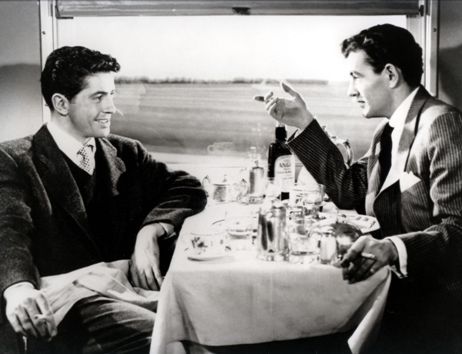Surely by now you’ve heard that Elizabeth Taylor passed away a few weeks ago in March. If you haven’t, well, now you have. What you probably haven’t heard is fellow Hollywood actor Farley Granger also died recently.
Granger was given the bad fortune of starting out with the great Alfred Hitchcock, where Hitchcock himself was the star. Granger’s first film with Hitchcock, “Rope,” was shot in continuous ten-minute static takes, and Jimmy Stewart was given first billing (and rightfully so), so the prospects of Granger becoming a star were slim. Following “Rope,” Granger starred in legendary cult director Nicholas Ray’s “They Live By Night.” After enduring several contracted movies that carried little interest for him, Granger salivated at the prospect of working with Hitchcock again.
It’s been sixty years since Granger’s best-known film “Strangers on a Train” was released. His turn in “Strangers on a Train” is solid, if somewhat unimpressive. He plays a soft, good-looking professional tennis player dragged into a criminal scenario through a chance encounter with a strangely sympathetic psychotic. His co-star Robert Walker completely overshadowed him, turning in one of the best cinematic villain performances.
Walker was released from the Menninger clinic, a psychiatric clinic in Topeka, Kansas, in May 1949, and Hitchcock sought him out with shooting to begin in 1950. Walker died near the end of shooting “Strangers on a Train” officially of respiratory failure. Walker was in a volatile state after drinking heavily. His psychiatrist administered a low-level dosage of the sedative sodium amytal, and Walker had a violent reaction that caused him to stop breathing and die at the age of 32.
The parallels between Walker and the late Heath Ledger are worth noting. Like Ledger, Walker died before the release of the role generally believed to be his best, both villainous roles no less. Like Walker, Ledger created subtle gestures that pushed his character into even creepier territories. In one particular scene, the resemblance is unmistakable. Walker’s character Bruno tells Granger’s character Guy, as he licks his lips much like Ledger did, “I’ve had a strenuous evening!” Walker stretches out ‘strenous’ much like Ledger did with certain words. Also, Walker rolls his eyes, as Ledger did, as if to tell us he’s in sheer ecstasy at his villainous actions, and he’s bored in the company of plain good guys.
With Ledger’s Joker character, you knew he wasn’t in a normal state of mind from the opening scene. The same applies to Walker’s Bruno character when he confides to a total stranger one of his many ideas for a perfect murder. “What is a life or two Guy? Some people are better off dead.” At this point, the audience knows he’s a little off-center but can’t stop watching, wondering what he will do next.
Walker also makes Bruno a sympathetic villain. Bruno cares for his mother, manicures his nails and wears pajamas with tennis rackets on them. Not exactly your run-of-the-mill villain.
While Granger’s passion was theater, he did reasonably well in film because he was photogenic. The studios, aware of this, tried to build him up with an endless schedule of public appearances, but he repeatedly refused. They wanted him to change his given name, but he wouldn’t budge. And if you had a name like Farley Granger, would you want to change your name? After “Strangers on a Train,” aside from the Luchino Visconti’s “Senso,” Granger’s movie career was more or less a wash. He returned to his passion on Broadway. Granger was perfectly cast in “Strangers on a Train,” but sadly even in his best-remembered film, he was upstaged by an actor channeling personal demons that he never overcame.









